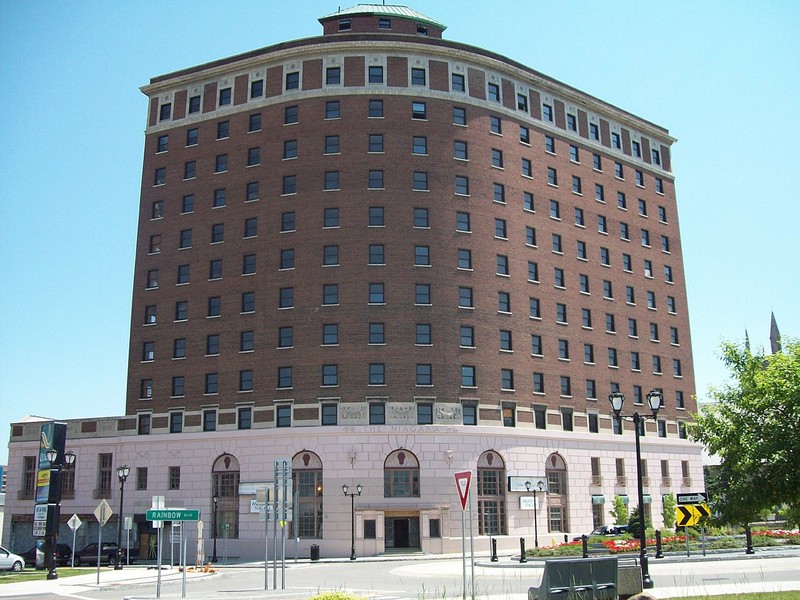The Hotel Niagara
Introduction
Text-to-speech Audio
With its curved shape and striking architecture, the former Hotel Niagara building is one of the most prominent landmarks in Niagara Falls. Erected in 1925, it was the last of the city's large hotels built in the early 1900s. The hotel was also notable for not being developed by one individual but rather the Chamber of Commerce and local residents. Its design combines elements of Italian Renaissance, Federal, and Adam architectural styles. The base consists of an artificial granite and limestone exterior with five arched openings, each of which contain decorative terra cotta panels. Other notable features include the terra cotta stringcourse and projecting cornice at the top of the building. As of July 2022, the building is vacant. A developer intended to restore it beginning in 2020 but the Covid-19 pandemic derailed those plans.
Images
Built in 1925, the former Niagara Hotel was the last of the grand hotels constructed in Buffalo in the early 1920s to cater to business travelers.

Backstory and Context
Text-to-speech Audio
By the 1920s, Niagara Falls had become a tourist destination and a major trade and industrial center. The hydroelectric electricity generated by the Niagara Falls powered the various industries that developed in the area. Wealthy tourists visited the Falls in the late 1800s but large numbers of middle class tourists started arriving after personal automobiles became more widespread. This robust economic activity attracted business travelers and conventions to the city. To better accommodate both, the Chamber of Commerce led the effort to build a new hotel (most of the hotels in the area at the time were geared for tourists). After two failed attempts, a 30-member committee led by the president of the Chamber of Commerce was formed in 1922 to raise funds through selling stocks. Hundreds in the community contributed to the effort. In this way, the hotel was promoted as hotel for and built by local residents.
The Hotel Niagara opened in April 1925. Operated by the United Hotels Company, it was considered state-of-the-art at the time, featuring fireproof construction, indoor plumbing and electricity. It was financially successful during the first few years but by 1929 was no longer profitable and by 1935 became community owned. The hotel continued to struggle until around 1946 when it began making money once again. It was sold in 1958 and operated until 1970 when it became the temporary home of the Guarding Life Insurance Company.
The building was mostly vacant in the 1970s but was purchased in 1977 and renovated by the new owner, John Prozeralik, who renamed it John's Hotel Niagara. The revamped hotel was successful and catered to foreign group or charter travel. Prozeralik sold it in 1988 and the new owner operated it as Days Inn-Falls and then as Travelodge Hotel-Fallsview. The hotel continued to be profitable, generating an annual average of $2.5 million between 1998 and 2002. However, it failed to pay $1.3 million in taxes and as a result was placed in foreclosure in 2005 and sold. The next hotel operator ran it until 2007, selling it to another owner who intended to renovate it, which never happened. In the coming years, the building was bought and sold a few times including most recently in 2019. The the Covid-19 pandemic stalled the renovation plans and in 2021 the city's tax incentives expired. It appears the developer is still working to raise funds to restore and reopen the hotel.
Sources
Prohaska, Thomas J. "Stalled Hotel Niagara project loses local tax break – at least for now." Buffalo News. February 10, 2021. https://buffalonews.com/news/local/stalled-hotel-niagara-project-loses-local-tax-break-at-least-for-now/article_a7f35afe-6bc1-11eb-b381-63ef5528bd2f.html.
Traynor, Kerry L. "The Niagara." National Park Service - National Register of Historic Places Nomination Form. December 5, 2008. https://s3.amazonaws.com/NARAprodstorage/lz/electronic-records/rg-079/NPS_NY/08001145.pdf
Wikimedia Commons: https://commons.wikimedia.org/wiki/File:The_Niagara_Jun_09.JPG
